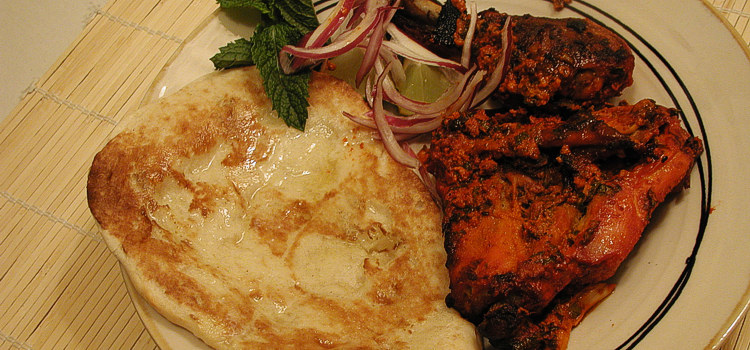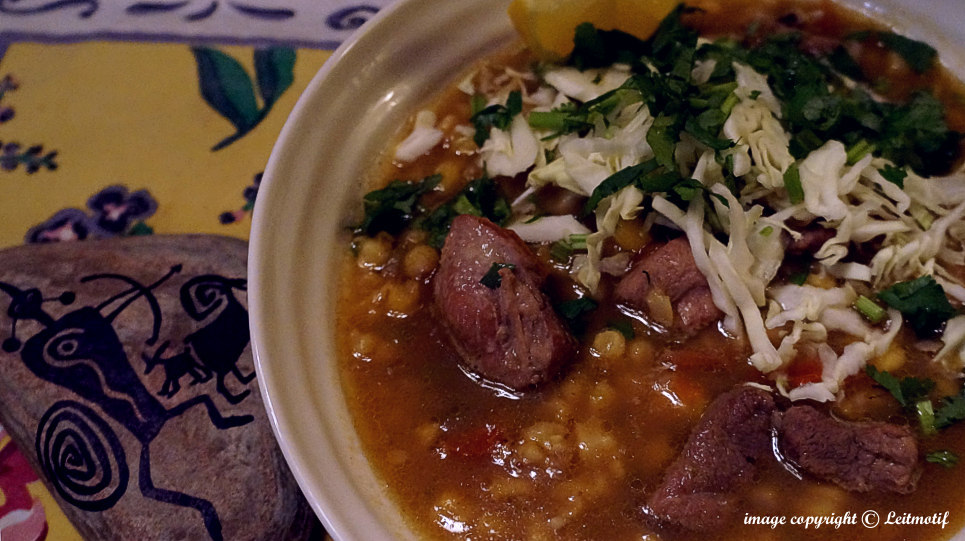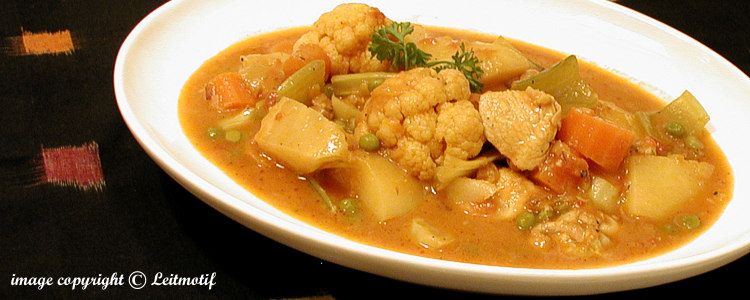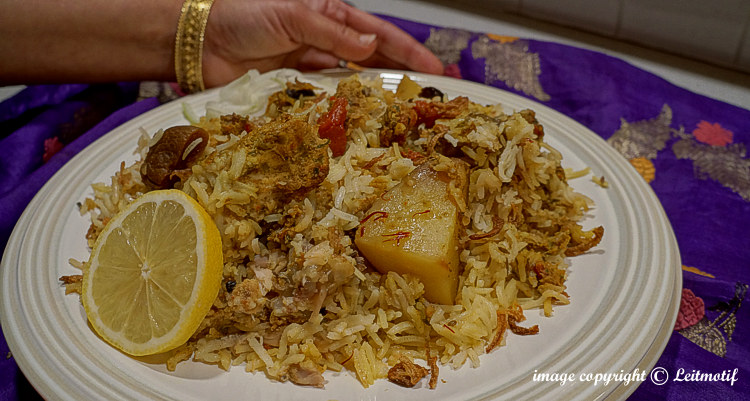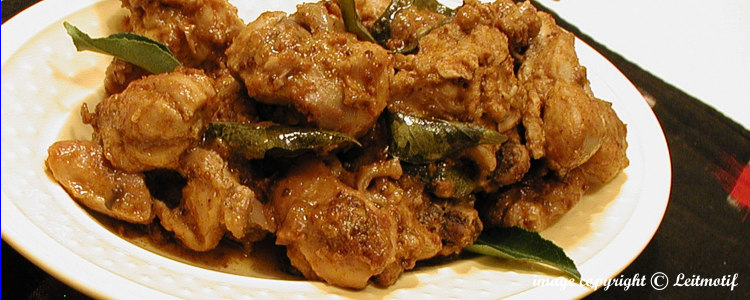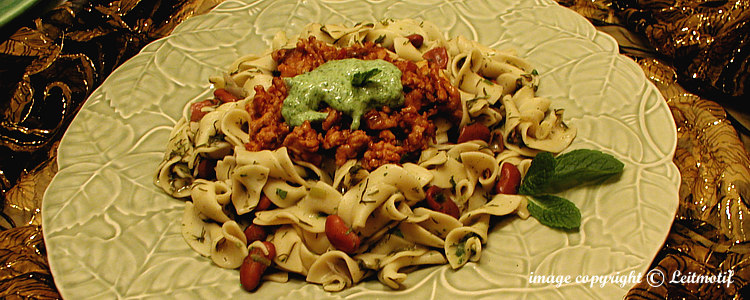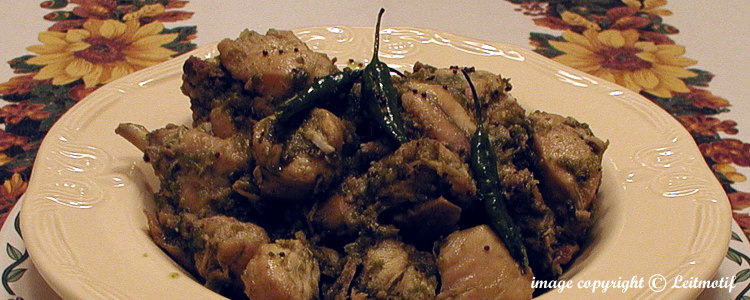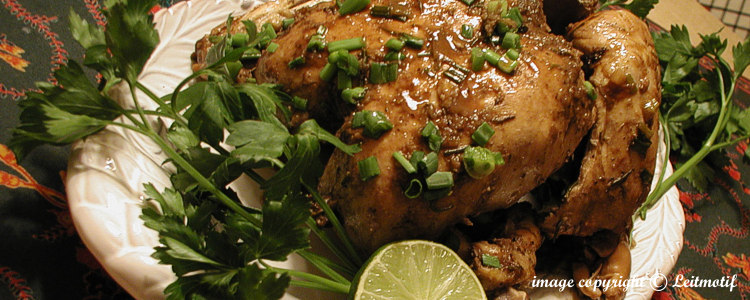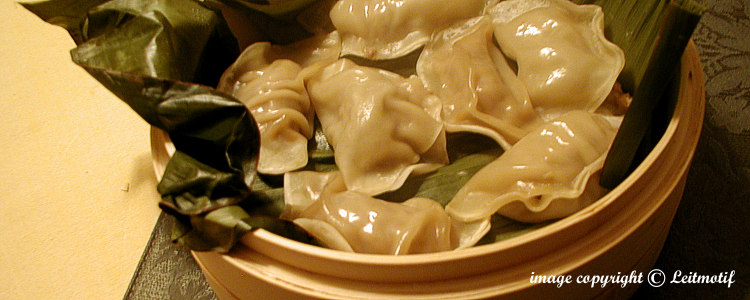From North India, tandoori chicken is either served whole or as large chicken pieces to be eaten with a bread called naan. Both chicken and naan are baked in a clay oven, called a ‘tandoor’. Alternatively the chicken can be cooked in an oven or in a grill (a charcoal grill is the best for this!).
Poultry & Meat
Chicken & Meat recipes
Posole with Chico & Rita
It was my first experience cooking hominy at home. I couldn’t find the dry grain at the local Whole Foods store (the store assistant was Mexican and said she made posole as well, but using only the canned version since the grains took forever to cook). I was determined to use the dry grain, and finally found it in the Spanish section in a grocery store. (Hominy is whole kernels of lime-treated maize, and when ground, you get the ‘masa’ for corn tortillas and tamales). To this Mexican stew of hominy and pork (you can use chicken instead) I added Hatch chiles from Hatch, New Mexico. Usually I order these roasted chiles online, but this particular time I was lucky to find them at the local grocer’s, so I roasted them myself at home – all in all a far too lengthy way to make posole, but so much fun! If you can’t get Hatch chiles substitute fresh poblanos that you can smear with oil and roast over the stove or in the oven. But really, it’s not the same thing.
Ishtoo ~ Anglo-Indian Stew
This is a bonafide Borthwick family recipe, a stew that was wolfed down with much enthusiasm. Anglo-Indian cooking is a unique and little-known tradition that evolved during the days of the British Raj in India. An era when English ‘sahibs’ had Indian butlers and cooks, the kitchen staff added regional touches to ‘English’ dishes, fortuitously creating one of the earliest fusion cuisines – an English menu elevated to new heights by injecting ingredients used in South Indian, Bengali, Goan and Mughlai cooking. This tradition continued in mixed race Anglo-Indian homes after the departure of the British in 1947.
North-Indian Chicken Biryani
Cooking biryani demands that I be in a bucolic if not sanguine state of mind – a well-tempered cook. The process can be quite laborious, but because the final result is so gob-smacking great, any Indian cook worth his or her salt will create this dish on special occasions – celebrations, big Sunday lunches and the like. It’s an absolute must for weddings of course, at which a professional cook or khansama, usually male, is employed. This khansama will bring along his helpers, utensils, charcoal stoves, ingredients and probably live chickens to the venue early in the morning. To watch the maestro go through the the various stages of preparation is fascinating if not mystifying, and epitomizes my approach to cooking. Ingredients are arbitrarily measured, spices vanish into the fire with a sleight of hand, and occasionally cooking time is measured by how long it takes the cook to smoke a certain number of cigarettes or bidis! Trust me, this almost haphazard style eventually served up a ‘haute cuisine’ creation that was worthy of Moghul royalty and we all felt like one when we ate it. My own mother would cook biryani in a a huge brass vessel (50 people for a birthday dinner was the norm) using the traditional Dum Pakht technique or the slow cooking technique over a low charcoal fire. The fragrant rice and spiced meat (usually mutton/goat) were layered in the vessel or hundi and the lid glued to the vessel with a thick paste of flour and water so as not to let the steam escape.
Chicken ’65
A trucker’s delight from Hyderabad (Andhra Pradesh), Chicken 65 is a great side with naan or roti, but can be more interesting as a starter accompanying a cool glass of beer.
Afghani Noodles
This is a Persian recipe (‘Ash-e Reshteh’) that I modified – very similar to the ash I sampled at an Afghan restaurant. ‘Ash-e’ means soup in Farsi but as you can see by the photograph above that mine is a drier version (albeit there is a fair amount of soup at the bottom to spoon over the noodles if you prefer). Persian noodles (Reshteh) are available in Middle Eastern food shops although I have used flat egg noodles from the grocery store (kosher section) with equal success. I sometimes substitute whole milk yogurt for sour cream if it is not on hand. This dish tastes better made a day ahead.
Chicken Chili Andhra style
If you like food with a hot garlicky green kick to it, this preparation from Andhra Pradesh, India is for you. I need to have this dish hot enough to make my eyes water, so if I’ve said to use six green chillies, you know better. Also, be brave and taste the chilli before you cook (just a quick lick to the inside of a slit chili), sometimes they aren’t as hot as they look so you’ll need to up the quantity! In authentic Andhra restaurants in India, they serve a small bowl of sugar cubes on the side, just in case your palate gets unbearably scorched!
Balsamic Lemongrass Roast Chicken
A fusion of Asian and Italian condiments, this is an easy to prepare dish – if it’s too tedious, skip the charcoal smoking step, and cook the chicken in the oven directly.
Steamed Chinese Dumplings
Dim Sum ranks high on my foodie outing list. I’m no expert, but if I can do it, you can. The most time-consuming part is making the dumplings and steaming them. But in the end, its totally worth it! You can add them to a soup, but I like to eat them as they are, with a mixture of soy sauce, rice vinegar and chilli. I’ve also made a vegetarian version with shredded cabbage. carrot and mushroom.
Andaa Kari ~ Egg Curry
An easy egg curry using hard-boiled eggs, with South Indian flavours using cardamom & coconut milk. (You can also modify the recipe and try the “Goa” version of anda curry by using a cup of diluted tamarind juice with the tomatoes, 1/4 tsp. of cinnamon powder and a tsp. of cumin to the dry spice mix. Use jaggery instead of sugar).

